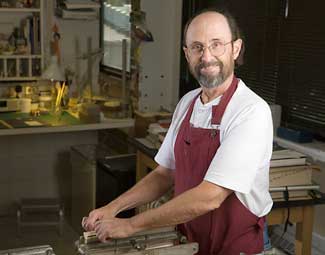Norm Harris, a bookbinder in the Library Conservation Lab, is determined to debunk the myth of the comic-book geek.
 |
|
(Photo by Lin Jones, U-M Photo Services)
|
He came of age during the turbulent 1960s. American comic books were the norm: superhero tales purchased at mom and pop drug stores. “Comic books at that time were still the creation of WWII veterans, people with strong beliefs in law and order, good versus evil,” Harris says.
“When I started, there was nothing. People sold comics out of their basements. There was also the stigma — last week, for example, I watched Fritz Lang’s ‘While the City Sleeps.’ A subplot is that a serial killer is at work. And how does Lang indicate that he’s crazy? Well, he reads comics.”
As an undergraduate at the University, Harris studied art.
Although he was a voracious reader of “above-ground comics,” he became aware that the counterculture revolution extended into the medium during his forays into underground Ann Arbor shops. “Robert Crumb created underground comics during the 1960s — he was put off by the superhero niche, so he stayed home, made his own and sold them on the streets of San Francisco.” Crumb and his followers were interested in a new kind of comic book — satirical, critical, uncensored.
|
Harris’ passion for art and originality persisted after graduation and a 12-month deployment to Vietnam. He worked a series of odd jobs in Ann Arbor before taking employment at Curious Books, a used-book store that also carried comics “to pull in the student crowd.” In 1974, the owner decided to close and Harris bought the store to sell comic books exclusively.
“We were the first place in town — and we put ‘underground’ comics on a standard spinner display, same as Mickey Mouse, not behind the counter.” Initially the store — The Eye of Agamotto (a reference of Marvel Comics’ Dr. Strange) — attracted primarily University students and die-hard comics fans.
Harris ran The Eye of Agamotto until 1986, when the economics of a one-man operation proved too strenuous. Harris then took a job at the Bessenberg Bindery, where he stayed for 14 years. “I love books, and this gave me a chance to see how the pages go together.”
In his current position as bookbinder at the Library Conservation Lab, Harris repairs books in circulation. “It’s astounding what’s inside these libraries,” he says. “It’s the best job I’ve ever had. That would include being up to my chin in comic books.”
Harris points out that the University has begun acquiring comics for its collection; rebinding and reformatting graphic novels has become a more common component of his work.
“I still collide with the arts,” Harris says. “The hunt. I’m a major league shopper — but comics are very difficult to keep.”
While Harris remains an expert on and fan of comics, don’t expect to see his own graphic contribution on the market anytime soon. “Creating a comic takes total commitment, 24 hours a day or an apprenticeship where you erase other people’s pencil lines. That’s part of the reason I love to read about the history of comics — these people … how did they get so good? They were compulsive. Obsessive.”

